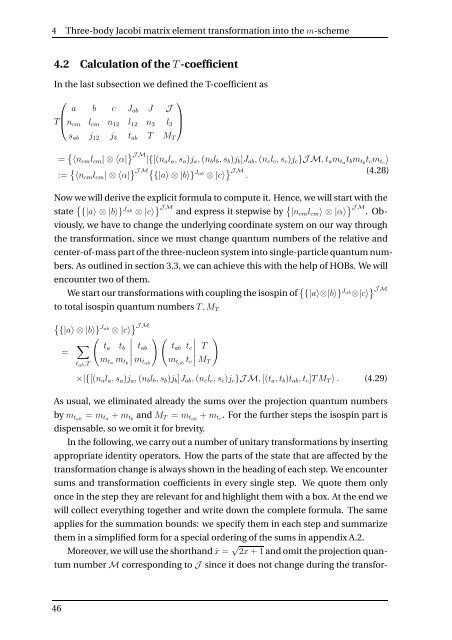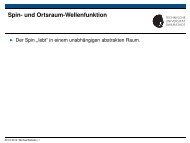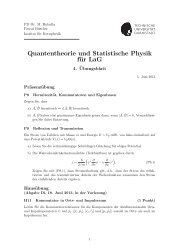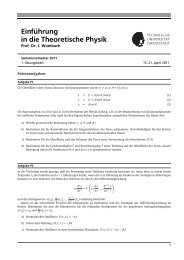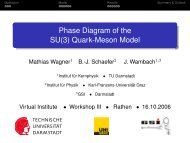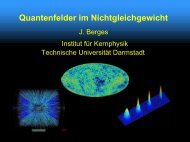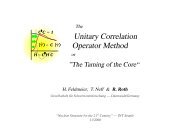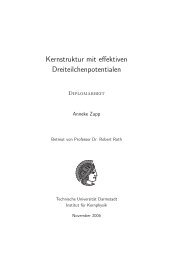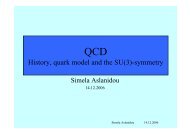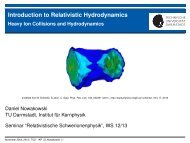Consistent chiral three-nucleon interactions in ... - Theory Center
Consistent chiral three-nucleon interactions in ... - Theory Center
Consistent chiral three-nucleon interactions in ... - Theory Center
Create successful ePaper yourself
Turn your PDF publications into a flip-book with our unique Google optimized e-Paper software.
4 Three-body Jacobi matrix element transformation <strong>in</strong>to the m-scheme<br />
4.2 Calculation of the T -coefficient<br />
In the last subsection we def<strong>in</strong>ed the T-coefficient as<br />
⎛<br />
⎞<br />
a b c Jab J J<br />
⎜<br />
⎟<br />
T⎝<br />
⎠<br />
ncm lcm n12 l12 n3 l3<br />
sab j12 j3 tab T MT<br />
= 〈ncmlcm| ⊗ 〈α| J M<br />
|{[(nala, sa)ja, (nblb, sb)jb]Jab, (nclc, sc)jc}J M, tamtatbmtb tcmtc〉<br />
:= 〈ncmlcm| ⊗ 〈α| J M <br />
Jab<br />
J M (4.28)<br />
{|a〉 ⊗ |b〉} ⊗ |c〉 .<br />
Now we will derive the explicit formula to compute it. Hence, we will start with the<br />
state {|a〉 ⊗ |b〉} Jab ⊗ |c〉 J M and express it stepwise by |ncmlcm〉 ⊗ |α〉 J M . Ob-<br />
viously, we have to change the underly<strong>in</strong>g coord<strong>in</strong>ate system on our way through<br />
the transformation, s<strong>in</strong>ce we must change quantum numbers of the relative and<br />
center-of-mass part of the <strong>three</strong>-<strong>nucleon</strong> system <strong>in</strong>to s<strong>in</strong>gle-particle quantum num-<br />
bers. As outl<strong>in</strong>ed <strong>in</strong> section 3.3, we can achieve this with the help of HOBs. We will<br />
encounter two of them.<br />
We start our transformations with coupl<strong>in</strong>g the isosp<strong>in</strong> of {|a〉⊗|b〉} Jab⊗|c〉 J M<br />
to total isosp<strong>in</strong> quantum numbers T, MT<br />
<br />
Jab<br />
J M<br />
{|a〉 ⊗ |b〉} ⊗ |c〉<br />
= <br />
<br />
<br />
ta tb tab<br />
<br />
<br />
tab,T<br />
mta mtb<br />
mtab<br />
tab tc<br />
mtab tc<br />
<br />
<br />
<br />
<br />
<br />
T<br />
MT<br />
<br />
×|{[(nala, sa)ja, (nblb, sb)jb]Jab, (nclc, sc)jc}J M, [(ta, tb)tab, tc]TMT 〉 . (4.29)<br />
As usual, we elim<strong>in</strong>ated already the sums over the projection quantum numbers<br />
by mtab = mta + mtb and MT = mtab + mtc. For the further steps the isosp<strong>in</strong> part is<br />
dispensable, so we omit it for brevity.<br />
In the follow<strong>in</strong>g, we carry out a number of unitary transformations by <strong>in</strong>sert<strong>in</strong>g<br />
appropriate identity operators. How the parts of the state that are affected by the<br />
transformation change is always shown <strong>in</strong> the head<strong>in</strong>g of each step. We encounter<br />
sums and transformation coefficients <strong>in</strong> every s<strong>in</strong>gle step. We quote them only<br />
once <strong>in</strong> the step they are relevant for and highlight them with a box. At the end we<br />
will collect everyth<strong>in</strong>g together and write down the complete formula. The same<br />
applies for the summation bounds: we specify them <strong>in</strong> each step and summarize<br />
them <strong>in</strong> a simplified form for a special order<strong>in</strong>g of the sums <strong>in</strong> appendix A.2.<br />
Moreover, we will use the shorthand ˆx = √ 2x + 1 and omit the projection quan-<br />
tum number M correspond<strong>in</strong>g to J s<strong>in</strong>ce it does not change dur<strong>in</strong>g the transfor-<br />
46


